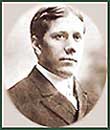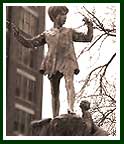History of Eldridge
R. Johnson Park
Camden, New Jersey
Eldridge R. Johnson
Park, and the former Cooper Library which stands at the
park’s center, represent one
of the most significant and unique cultural, historic,
and artistic resources in the City of Camden and the State
of New Jersey.
Built between 1914 and 1930,
the complex occupies an entire block near Camden's waterfront
on the Rutgers-Camden campus. When it opened in 1918, the
site became southern New Jersey's foremost cultural and
recreational center. Today, the library houses the Walt
Whitman Arts Center and is owned by Rutgers-Camden. The
site has been designated as a State and Federal Historic
Landmark and is currently undergoing extensive rehabilitation
to preserve its splendor for future generations.
 The
project for these facilities was the brainchild of Eldridge
R. Johnson, founder of the world renowned Victor Talking
Machine Company and one of Camden’s most important
philanthropists, who donated the Neo-Classical
Cooper Branch Library and surrounding Johnson Park to the
City of Camden. The
project for these facilities was the brainchild of Eldridge
R. Johnson, founder of the world renowned Victor Talking
Machine Company and one of Camden’s most important
philanthropists, who donated the Neo-Classical
Cooper Branch Library and surrounding Johnson Park to the
City of Camden.
Constructed in several stages
between 1916 and 1930, Johnson Park’s
grand design exhibits a classic symmetry and formality
offset by delightful and original pieces of sculpture and
a diverse collection of trees.
Eldridge Johnson’s
Vision
From his office on the seventh floor
of the Victor Talking Machine Company’s executive building at Front and
Cooper Streets, Eldridge Johnson had a vision. He
imagined a cultural center for the benefit of local employees
and city residents and a park where children from all over
the region would come to play.
To bring this dream
to fruition, Johnson proposed and personally managed the
design and oversaw the construction of the Classical Revival
style Cooper Library and an equally magnificent park.
| |
|
|
| |
Victor Talking Machine plant (ca.
1920) |
|
The park exudes a sense of
youthful enjoyment and amusement. In every aspect of the
park’s design, from the fountains
and sculptures to the beautiful colored tiles representing
children’s nursery rhymes, Johnson’s love for
children can be seen. In fact, the story is told
that Mr. Johnson converted, what was originally intended
to be a lily pond, to a wading pool after the pond immediately
filled with children before it could be completely filled
with the water and the lilies had arrived.
| |
|
|
| |
Wading
Pools in Johnson Park
(ca. 1920) |
|
As a result,
instead of adding lily pads, Johnson ordered changing
pagodas to be added to the park, one for boys and one for
girls. Lovely
plantings completed the park, which by 1930 had become
an international tourist destination.
Art & Architecture
 The “Peter Pan” sculpture which stands at
the park’s entrance is one of only five in the world. Made
by Sir George Frampton, the “Peter Pan” is
perhaps his most famous work. The original stands
in Kensington Gardens, London, England. The “Peter Pan” sculpture which stands at
the park’s entrance is one of only five in the world. Made
by Sir George Frampton, the “Peter Pan” is
perhaps his most famous work. The original stands
in Kensington Gardens, London, England.
This 11’ cast
bonze statue replica was purchased by Eldridge Johnson
for Johnson Park. Peter Pan’s arrival to Camden
on September 24, 1926 was a momentous occasion. To
celebrate the dedication, a Peter Pan pageant committee
organized over 3,000 schoolchildren from Camden, Merchantville,
and nearby towns to depict scenes from the story of Peter
Pan. (See image below) Schools closed early, and over
10,000 people from across the region attended.
| |
|
|
| |
Peter
Pan Pageant Johnson
Park (1926) |
|
In 1930, a distinctive cast bronze fence, designed by Otto
Schweitzer, a Philadelphia sculptor, was added to surround
the Peter Pan sculpture. The
fence is shaped in an irregular, complex, open mesh
of birds, fish and flowers, 28” high with a circumference
of 45”.
In addition, it is at Johnson
Park that the most complete group of outdoor sculptures
by Philadelphia sculptor Albert Laessle can be found. “Billy,” “Dancing
Goat,” “Pan,” and “Turtle and
Duck” are
among the whimsical additions to the park.
For more information on the
marvelous Victor Talking Machine, visit http://en.wikipedia.org/wiki/Victor_Talking_Machine_Company
Read about Enrico
Caruso's recording
"Over
there" (1918) at RCA Camden and listen
to this soundtrack (2:48 min) by visiting the Internet
Archive and clicking on the title in the dark gray box.
http://www.archive.org/details/overthere1918
Read about a seminar by the
Camden County Historical Society
(includes links to video files)
http://historiccamdencounty.com/ccnews110.shtml |